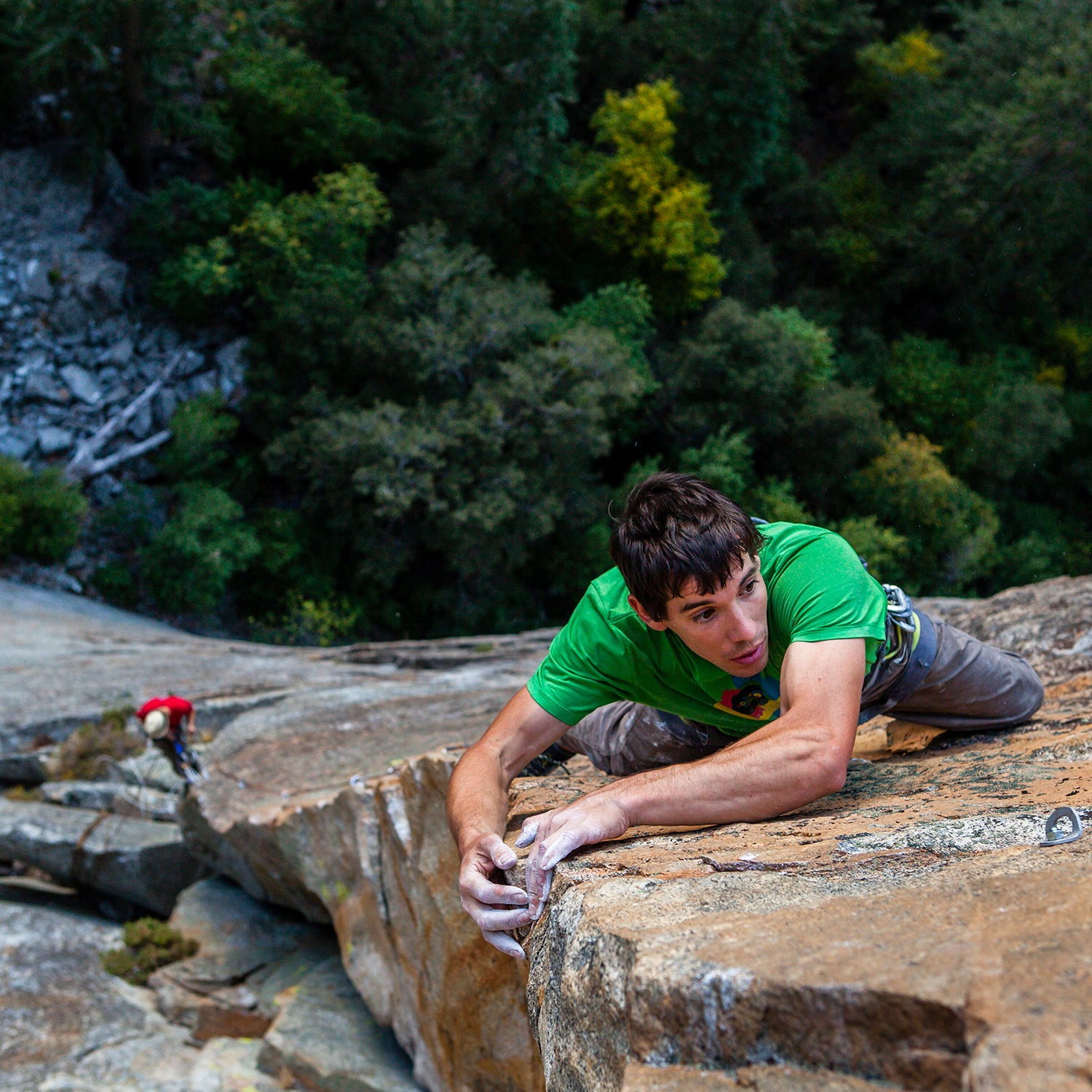Alex Honnold is a big-wall climber whose audacious free solos—no ropes, no partner—of America’s iconic rock faces have made him one of the most recognized and followed adventure athletes in the world. He is distinguished for his uncanny ability to control his fear while scaling cliffs of dizzying heights without anything to protect him if he falls.
Honnold’s achievements include the first free solos of 1,200-foot Moonlight Buttress in Utah’s Zion National Park and the 2,200-foot Northwest Face of Half Dome, in Yosemite. In 2012, he achieved Yosemite’s first so-called Triple Solo: climbing, in succession, the park’s three biggest faces—Mount Watkins, Half Dome, and El Capitan—alone in under 24 hours. In June, he and Tommy Caldwell became the first people to climb the Nose route on Yosemite’s El Capitan in under two hours.
He is also the founder of the , an environmental non-profit. To this day, he maintains a simple dirtbag climber existence, living mostly out of his van and traveling the world in search of his next great vertical adventure.
During a long interview on , Honnold discussed his relationship to fear, risk, and other mental challenges in sports and life. Below is an excerpt of their conversation, edited by ���ϳԹ���.
When you are getting ready for a challenging climb, what does your self-talk sound like? Do you have any anything you ritualistically say to yourself before you get going?
No, I don't really. I don't self-talk like that. But normally if I’m planning on doing something challenging, I spend the time visualizing what the experience will feel like. With climbing, there’s a component of memorizing the actual moves. So I’ll think through the sequences and make sure that I remember which foot to move in which order and like how to do everything. And then if I’m climbing ropeless, then I’ll think through what it’ll feel like to be in certain positions. Because some kinds of movements are just scarier. It’s important to to think through how that will all feel when I’m up there, so that when I’m doing it I won’t suddenly be like, Oh my God, this is really scary. I know that it’s supposed to be scary, I know what it’s going to feel like, and I just do it.
So do you climb hard routes in an absence of fear? Or is it something you have to overcome while climbing?
I generally climb hard routes in the absence of fear. Though it’s important to differentiate fear and risk. If there is a high level of risk, you should be feeling fear. It’s a warning that there is real danger. Typically if I’m feeling a lot of fear, then I wait and prepare more, do whatever it takes to mitigate that, and then do the climb when I feel comfortable.
Do you have a checklist you go through before a free-solo? Like, I have to do this X number of times and then do this Y number of times first?
I don’t have a checklist, but I definitely have a degree of comfort that I need to feel on the route before I’m willing to free-solo it.
What does that feel like?
I need to have a certain amount of reserve. I need to feel like I can climb the route in a variety of conditions and have some extra in the tank just in case. If I can climb the route only by the narrowest of razor thin margins, that’s not good enough for free-soloing.
As the first superstar of free-soloing, do you ever have concerns about the influence you could have on young climbers?
So, two things. One, I’m definitely not the first superstar, because there are a bunch of European climbers who are well known for free-soloing who came before me. And even in the U.S. somebody like John Bachar was well-known in the 1970s. I was a kid who was influenced by earlier free-solo climbers and I’ve thought a bit about influencing kids and wondering if that’s a bad thing. Soloing is self-regulating in a way. Anybody can watch a video and think, I want to do that. But as soon as they climb 15 or 20 feet off the ground they start to have a very frank discussion with themselves, like, Do I really want to do this?
In general, you just don’t really see copycats like you see in gravity assisted sports or action sports. In kayaking or skiing or something, anybody can just stand at the top of the cliff and say, “I’m gonna hit this cliff and I’m going to stick it and it’s gonna be sick.” Once they commit, they’re going of the cliff one way or another. But with climbing, each move you make is a decision that you’re going to continue upward. You have to decide over and over, I want to keep going, I want to keep going. And at a certain point you’re like, I don’t really want to keep going. I think I wanna go down. And then you’re just like, Mommy!
Are there lessons you’ve learned or skills you’ve developed in climbing that translate to other parts of your life?
From the actual climbing itself, the most useful thing I’ve learned is how to differentiate risk and consequence and fear, and how to separate my feelings from what’s actually happening. When you're really hungry you’re not like, Oh God, I’m hungry, I’m hungry! You're just like, Oh, I’ll eat lunch in two hours. Fear to some extent should be the same way. You can register, Oh, I’m feeling fear right now, but know that sometimes that doesn’t matter. Sometimes it does, and you need to watch out for that. But a lot of times, you should be able to set that fear aside and do exactly what you're supposed to be doing.
Do you ever see a point where you’ll feel like you’ve accomplished all that you can in climbing?
In climbing, compared to most other professional sports, you can have quite a long career because there’s always more you can do with trips and expeditions and first ascents. And there’s a really creative process to it. I come up with interesting challenges and things that nobody’s thought of before. There are professional climbers in their 50s that are still getting after it like that.
But I can definitely see a point where I wouldn’t continue pushing. There is always a “what’s next?” in climbing. You can always try to improve in some way. I can see a point at which I’m like, OK, I’m satisfied, I’ve done what I needed to do.


